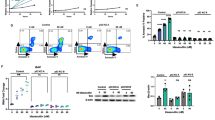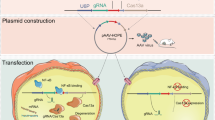Abstract
Most of cells exhibit low nuclear level of NF-κB. However, in some cell lines and tissues aberrantly activated NF-κB is playing an important role in cell motility, growth control and survival. Here we describe the result of decrease of constitutive NF-κB level in different adenocarcinoma cell lines. Treatment of mouse adenocarcinoma cell line CSML-100 with both synthetic (TPCK or PDTC) or natural (IκB-α) NF-κB inhibitors caused apoptotic death. Low doses of TPCK were harmless for CSML100 cells but sensitized them to TNF-induced apoptosis. Death of CSML100 cells in the presence of high concentration TPCK was not accompanied with significant changes in c-myc activity but strongly correlated with rapid decrease in p53 level. Thus, mutual behavior p53 and NF-κB represented a unique feature of TPCK-induced apoptosis in CSML-100 adenocarcinoma cells. Cell Death and Differentiation (2001) 8, 621–630
Similar content being viewed by others
Log in or create a free account to read this content
Gain free access to this article, as well as selected content from this journal and more on nature.com
or
Abbreviations
- EMSA:
-
electrophoretic mobility shift assay (gel shift)
- PDTC:
-
pyrrolidine ithiocarbamate
- PI:
-
propidium iodide
- PS:
-
phosphatidylserine
- ROS:
-
reactive oxygen species
- TNFα:
-
tumor necrosis factor α
- TPCK:
-
N-tosyl-L-phenylalanine chloromethyl ketone
References
Rayet B, Gelinas C . 1999 Aberrant rel/nfkb genes and activity in human cancer Oncogene 18: 6938–6947
Karin M . 1999 The beginning of the end: IkappaB kinase (IKK) and NF-kappaB activation J. Biol. Chem. 274: 27339–27342
Traenckner EB, Pahl HL, Henkel T, Schmidt KN, Wilk S, Baeuerle PA . 1995 Phosphorylation of human I kappa B-alpha on serines 32 and 36 controls I kappa B-alpha proteolysis and NF-kappa B activation in response to diverse stimuli EMBO J. 14: 2876–2883
DiDonato JA, Hayakawa M, Rothwarf DM, Zandi E, Karin M . 1997 A cytokine-responsive IkappaB kinase that activates the transcription factor NF-kappaB Nature 388: 548
Regnier CH, Song HY, Gao X, Goeddel DV, Cao Z, Rothe M . 1997 Identification and characterization of an IkappaB kinase Cell 90: 373–383
Chen Z, Hagler J, Palombella VJ, Melandri F, Scherer D, Ballard D, Maniatis T . 1995 Signal-induced site-specific phosphorylation targets I kappa B alpha to the ubiquitin-proteasome pathway Genes Dev. 9: 1586–1597
Baldwin Jr AS . 1996 The NF-kappa B and I kappa B proteins: new discoveries and insights Annu. Rev. Immunol. 14: 649–683
Baeuerle PA, Baichwal VR . 1997 NF-kappa B as a frequent target for immunosuppressive and anti-inflammatory molecules Adv. Immunol. 65: 111–136
May MJ, Ghosh S . 1998 Signal transduction through NF-kappa B Immunol. Today 19: 80–88
Chu ZL, McKinsey TA, Liu L, Gentry JJ, Malim MH, Ballard DW . 1997 Suppression of tumor necrosis factor-induced cell death by inhibitor of apoptosis c-IAP2 is under NF-kappa B control Proc. Natl. Acad. Sci. USA 94: 10057–10062
Wang CY, Mayo MW, Korneluk RG, Goeddel DV, Baldwin AS . 1998 NF-kappa B antiapoptosis: induction of TRAF1 and TRAF2 and c-IAP1 and c-IAP2 to suppress caspase-8 activation Science 281: 1680–1683
Wang CY, Mayo MW, Baldwin AS . 1996 TNF- and cancer therapy-induced apoptosis: potentiation by inhibition of NF-kappa B Science 274: 784–786
Van Antwerp DJ, Martin SJ, Kafri T, Green DR . 1996 Suppression of TNF-alpha-induced apoptosis by NF-kappa B Science 274: 787–789
Lin B, Williams-Skipp C, Tao Y, Schleicher MS, Cano LL, Duke RC, Scheinman RI . 1999 NF-kappa B functions as both a proapoptotic and antiapoptotic regulatory factor within a single cell type Cell Death Differ. 6: 570–582
Qin ZH, Chen RW, Wang Y, Nakai M, Chuang DM, Chase TN . 1999 Nuclear factor kappaB nuclear translocation upregulates c-Myc and p53 expression during NMDA receptor-mediated apoptosis in rat striatum J. Neurosci. 19: 4023–4033
Kaltschmidt C, Kaltschmidt B, Neumann H, Wekerle H, Baeuerle PA . 1994 Constitutive NF-kappa B activity in neurons Mol. Cell Biol. 14: 3981–3992
Wu M, Lee H, Bellas RE, Schauer SL, Arsura M, Katz D, FitzGerald MJ, Rothstein L, Sherr Dh, Sonenshein GE . 1996 Inhibition of NF-kappa B/Rel induces apoptosis of murine B cells EMBO J. 15: 4682–4690
Bellas RE, FitzGerald MJ, Fausto N, Sonenshein GE . 1997 Inhibition of NF-kappa B activity induces apoptosis in murine hepatocytes Am. J. Pathol. 151: 891–896
Sovak MA, Bellas RE, Kim DW, Zanieski GJ, Rogers AE, Traish AM, Sonenshein GE . 1997 Aberrant nuclear factor-kappaB/Rel expression and the pathogenesis of breast cancer J. Clin. Invest. 100: 2952–2960
Bargou RC, Leng C, Krappmann D, Emmerich F, Mapara MY, Bommert K, Royer HD, Scheidereit C, Dorken B . 1996 High-level nuclear NF-kappa B and Oct-2 is a common feature of cultured Hodgkin/Reed-Sternberg cells Blood 87: 4340–4347
Wood KM, Roff M, Hay RT . 1998 Defective IkappaBalpha in Hodgkin cell lines with constitutively active NF-kappa B Oncogene 16: 2131–2139
Bargou RC, Emmerich F, Krappmann D, Bommert K, Mapara MY, Arnold W, Royer HD, Grinstein E, Greiner A, Scheidereit C, Dorken B . 1997 Constitutive nuclear factor-kappaB-RelA activation is required for proliferation and survival of Hodgkin's disease tumor cells J. Clin. Invest. 100: 2961–2969
La Rosa FA, Pierce JW, Sonenshein GE . 1994 Differential regulation of the c-myc oncogene promoter by the NF-kappa B rel family of transcription factors Mol. Cell Biol. 14: 1039–1044
Kirch HC, Flaswinkel S, Rumpf H, Brockmann D, Esche H . 1999 Expression of human p53 requires synergistic activation of transcription from the p53 promoter by AP-1, NF-kappa B and Myc/Max Oncogene 18: 2728–2738
Ravi R, Mookerjee B, van Hensbergen Y, Berdi GC, Giordano A, El-Deiry WS, Fuchs EJ, Berdi A . 1998 p53-mediated repression of nuclear factor-kappaB RelA via the transcriptional integrator p300 Cancer Res. 58: 4531–4536
Webster GA, Perkins ND . 1999 Transcriptional cross talk between NF-kappa B and p53 Mol. Cell Biol. 19: 3485–3495
Mayo MW, Wang CY, Cogswell PC, Rogers-Graham KS, Lowe SW, Der CJ, Baldwin Jr AS . 1997 Requirement of NF-kappa B activation to suppress p53-independent apoptosis induced by oncogenic Ras Science 278: 1812–1815
Senin VM, Ivanov AM, Afanasyeva AV, Buntsevich AM . 1984 Vestnik USSR Acad. Med. Sci. 5: 85–91
Korobko EV, Saschenko LP, Prockhortchouk EB, Korobko IV, Gnuchev NV, Kiselev SL . 1999 Resistance to tumor necrosis factor induced apoptosis in vitro correlates with high metastatic capacity of cells in vivo Immunology Letters 67: 71–76
Tulchinsky E, Prokhortchouk E, Georgiev G, Lukanidin E . 1997 A kappaB-related binding site is an integral part of the mts1 gene composite enhancer element located in the first intron of the gene J. Biol. Chem. 272: 4828–4835
Schreck R, Meier B, Mannel DN, Droge W, Baeuerle PA . 1992 Dithiocarbamates as potent inhibitors of nuclear factor kappa B activation in intact cells J. Exp. Med. 175: 1181–1194
Hjelmsoe I, Allen CE, Cohn MA, Tulchinsky EM, Wu LC . 2000 The kappaB and V(D)J recombination signal sequence binding protein KRC regulates transcription of the mouse metastasis-associated gene S100A4/mts1 J. Biol. Chem. 275: 913–920
Kriajevska M, Tarabykina S, Bronstein I, Maitland N, Lomonosov M, Hansen K, Georgiev G, Lukanidin E . 1998 Metastasis-associated Mts1 (S100A4) protein modulates protein kinase C phosphorylation of the heavy chain of nonmuscle myosin J. Biol. Chem. 273: 9852–9856
Giri D, Aggarwal BB . 1998 Constitutive activation of NF-kappa B causes resistance to apoptosis in human cutaneous T cell lymphoma HuT-78 cells. Autocrine role of tumor necrosis factor and reactive oxygen intermediates J. Biol. Chem. 273: 14008–14014
Ziegler-Heitbrock HW, Sternsdorf T, Liese J, Belohardsky B, Weber C, Wedel A, Schereck R, Baeuerle PA . 1993 Pyrrolidine dithiocarbamate inhibits NF-kappa B mobilization and TNF production in human monocytes J. Immunol. 151: 6986–6993
Wu M, Arsura M, Bellas RE, FitzGerald MJ, Lee H, Schauer SL, Sherr DH, Sonenshein GE . 1996 Inhibition of c-myc expression induces apoptosis of WEHI 231 murine B cells Mol. Cell Biol. 16: 5015–5025
Ryan K, Ernst M, Rice N, Vousden K . 2000 Role of NF-kB in p53-mediated programmed cell death Nature 404: 892–897
Miyamoto S, Seufzer BJ, Shumway SD . 1998 Novel IkappaB alpha proteolytic pathway in WEHI231 immature B cells Mol. Cell Biol. 18: 19–29
Ausubel FM, Brent R, Kingston RE, Moore DD, Seidman JG, Smith JA, Struhl K . 1987 In: Current Protocols in Molecular Biology Wiley and Sons pp. 2.12 and 12.31–12.35
Schreiber E, Matthias P, Muller MM, Schaffner W . 1989 Rapid detection of octamer binding proteins with ‘mini-extracts’, prepared from a small number of cells Nucleic Acids Res. 17: 6420
Acknowledgements
We thank Dr. Peter Chumakov for providing antibodies and significant help in discussion of this paper, Dr. Nancy Rice for providing us with IκB-wt and IκB-mut expression vectors, Elsa Fabretti (ICGEB) for substantial help with microinjection experiment and Dana Aithozhina for cell culture work. The work was supported by Russian Fund for Basic Research Grant N 99-03346 for A Smirnov and AV Prokhortchouk ICGEB fellowship programme for AS Ruzov and EB Prokhortchouk.
Author information
Authors and Affiliations
Corresponding author
Additional information
Edited by G Ciliberto
Rights and permissions
About this article
Cite this article
Smirnov, A., Ruzov, A., Budanov, A. et al. High constitutive level of NF-κB is crucial for viability of adenocarcinoma cells. Cell Death Differ 8, 621–630 (2001). https://doi.org/10.1038/sj.cdd.4400853
Received:
Revised:
Accepted:
Published:
Issue date:
DOI: https://doi.org/10.1038/sj.cdd.4400853
Keywords
This article is cited by
-
Modeling the therapeutic efficacy of NFκB synthetic decoy oligodeoxynucleotides (ODNs)
BMC Systems Biology (2018)
-
The Gβ5 protein regulates sensitivity to TRAIL-induced cell death in colon carcinoma
Oncogene (2015)
-
Association of nuclear factor κB expression with a poor outcome in nasopharyngeal carcinoma
Medical Oncology (2011)
-
MnSOD protects colorectal cancer cells from TRAIL-induced apoptosis by inhibition of Smac/DIABLO release
Oncogene (2008)
-
Tumor necrosis factor α sensitizes malignant cells to chemotherapeutic drugs via the mitochondrial apoptosis pathway independently of caspase-8 and NF-κB
Oncogene (2004)



